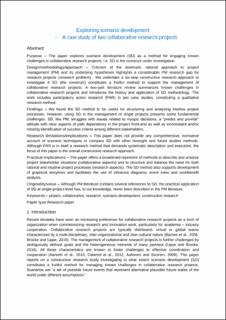| dc.description.abstract | Purpose
The purpose of this paper is to explore scenario development (SD) as a method for engaging known challenges in collaborative research projects, i.e. SD is the construct under investigation.
Design/methodology/approach
Criticism of the dominant, rational approach to project management (PM) and its underlying hypotheses highlights a considerable PM research gap for research projects (research problem). The authors undertake a six-step constructive research approach to investigate if SD (the construct) constitutes a fruitful method to support the management of collaborative research projects. A two-part literature review summarizes known challenges in collaborative research projects and introduces the history and application of SD methodology. The work includes participatory action research (PAR) in two case studies, constituting a qualitative research method.
Findings
The authors found the SD method to be useful for structuring and analyzing intuitive project processes. However, using SD in the management of single projects presents some fundamental challenges. SD, like PM, struggles with issues related to myopic decisions, a “predict and provide” attitude with clear aspects of path dependency in the project front-end as well as inconsistent and/or missing identification of success criteria among different stakeholders.
Research limitations/implications
This paper does not provide any comprehensive, normative account of scenario techniques or compare SD with other foresight and future studies methods. Although PAR is in itself a research method that demands systematic description and execution, the focus of this paper is the overall constructive research approach.
Practical implications
The paper offers a broadened repertoire of methods to describe and analyse project stakeholder situations (collaborative aspects) and to structure and balance the need for both rational and intuitive project processes (research aspects). The SD method also supports development of graphical storylines and facilitates the use of influence diagrams, event trees and cost/benefit analysis.
Originality/value
Although PM literature contains several references to SD, the practical application of SD at single-project level has, to the authors’ knowledge, never been described in the PM literature. | en_US |
